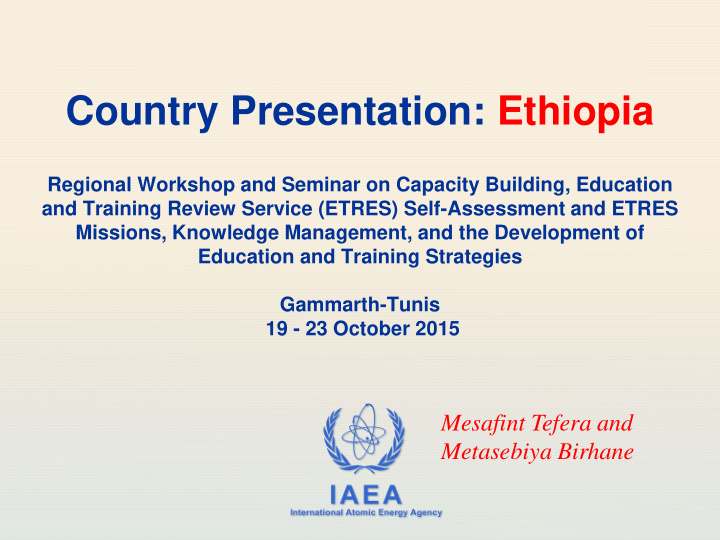



Country Presentation: Ethiopia Regional Workshop and Seminar on Capacity Building, Education and Training Review Service (ETRES) Self-Assessment and ETRES Missions, Knowledge Management, and the Development of Education and Training Strategies Gammarth-Tunis 19 - 23 October 2015 Mesafint Tefera and Metasebiya Birhane IAEA International Atomic Energy Agency
Content 1. country’s nuclear safety/radiological protection infrastructures/plans 2. national nuclear/radiological regulator(s) 3. nuclear/radiological training facilities / programs 4. collaboration on regional/international level programs on the area 5. Summary of the main challenges and the need of support form IAEA IAEA 2
country’s nuclear safety/radiological protection infrastructures/plans HISTROY OF Radiation Protection IN ETHIOPIA Ethiopia historically introduced radiation technology away back in the 1960s at the then medical facility called Emperor Haile Sellasie Hospital. The following two decades laid a strong foundation for the genesis of the Authority There was no legal enforcement except willingness to take the services and comply IAEA 3
country’s nuclear... Ctd HISTROY OF RP IN ETHIOPIA… Ctd The legislation governing the regulatory control of ionizing radiation sources was in acted 1993 But it is changed by 571/2008 Now Ethiopian Radiation Protection Authority/ERPA/ is the main responsible body to work on radiation protection IAEA 4
country’s nuclear... Ctd Nuclear safety/radiological protection infrastructures Basic human recourse to execute the main activities of the ERPA are established; 86 STAFF OF WHICH 28 ARE TECHNICAL The Authority shall run its activities by a budget allocated by the government. IAEA 5
country’s nuclear... Ctd PHYSICAL FACILITIES Modest physical facilities in general exist Food and Environment Lab Central Radioactive Waste Processing and Storage Facility IAEA 6
National nuclear/radiological regulator(s) ERPA is the main responsible body and it empower by RP proclamation To Formulate radiation protection Issue/policies, To Establish a system for coordinating public and private activities, To Carryout inspection and take appropriate measures to ensure compliance with radiation protection laws and directives; To Issue directives for the implementation polices and laws concerning radiation protection and follow up their implementation IAEA 7
National nuclear/radiological regulator(s) ERPA is the main responsible body… Ctd Mission To protect individuals, society and environment in current and future generation against the harmful effects of radiation, while ensuring the safe and peaceful exploitation of ionizing radiation and related nuclear techniques for the benefit of Ethiopia’s national development. Vision To see a country that has started utilizing radiation and related nuclear techniques widely and is well protected from its adverse effect by 2025. IAEA 8
National nuclear/radiological regulator(s) Like wise science and technology information centre /STIC/ • is one of the responsible body with the mission to identify, gather, organize, analyze and add value through research, as well as disseminate a S&T information to accelerate the country’s technology transfer • The center is organized with 3 core directorate, of which one is knowledge management and dissemination directorate. • This directorate collect and manage different science and technology knowledge including publications and research outputs on nuclear IAEA 9
nuclear/radiological training facilities / programs Training and awareness creation programs by ERPA IAEA 10
collaboration on regional/ international level programs on the area Co-ordination and Co-operation at a national level • With EFDRE ministry of health • Addis Ababa city administration fire and accident protection authority የኢትዮጵያ ፌዴራላዊ ዲሞክራሲያዊ ሪፐብሊክ የጤና ጥበቃ ሚ / ር በአዲስ አበባ ከተማ አስተዳደር በእሳትና ድንገተኛ አደጋዎች መከላከልና መቆጣጠር ባለስልጣን IAEA 11
collaboration… Ctd International Co-operation and Collaboration • AFRA • Us department of energy • FNRBA • IAEA • AU IAEA 12
Summary of the main challenges and the need of support form IAEA main challenges Less skilled human resource and High turn over of skilled man power Lack of research institutions Low level radiation safety culture among the general public including the learned once. Unified coordination and Collaboration that optimize resources at the local level has not yet been realized. Dependency with donors (mainly IAEA) in major technical equipment and training is observed, even if the country is a member IAEA 13
support form IAEA More has to be done in establishing research institutions so as to contribute a lot to the R&D activities in the country And supporting academic institutions either financially or technically to create skilled human resource as well as radiation safety culture in the country to meet the growing need of nuclear application Supporting ERPA is needed to give strength to its regulatory system and operate with highly skilled manpower in line with strong legal and policy framework so as to contribute a lot to the national growth in the peaceful purposive process of nuclear technology. IAEA 14
support ….Ctd Most of all, supporting Ministry of science and technology /MoST/ in general and STIC in particular is very essential to create a better awareness on safe use of nuclear technology; it is because these two organizations are working to establish science and technology culture in the country IAEA 15
THANK YOU Coordinated action is needed both at the national and international level IAEA 16
Recommend
More recommend